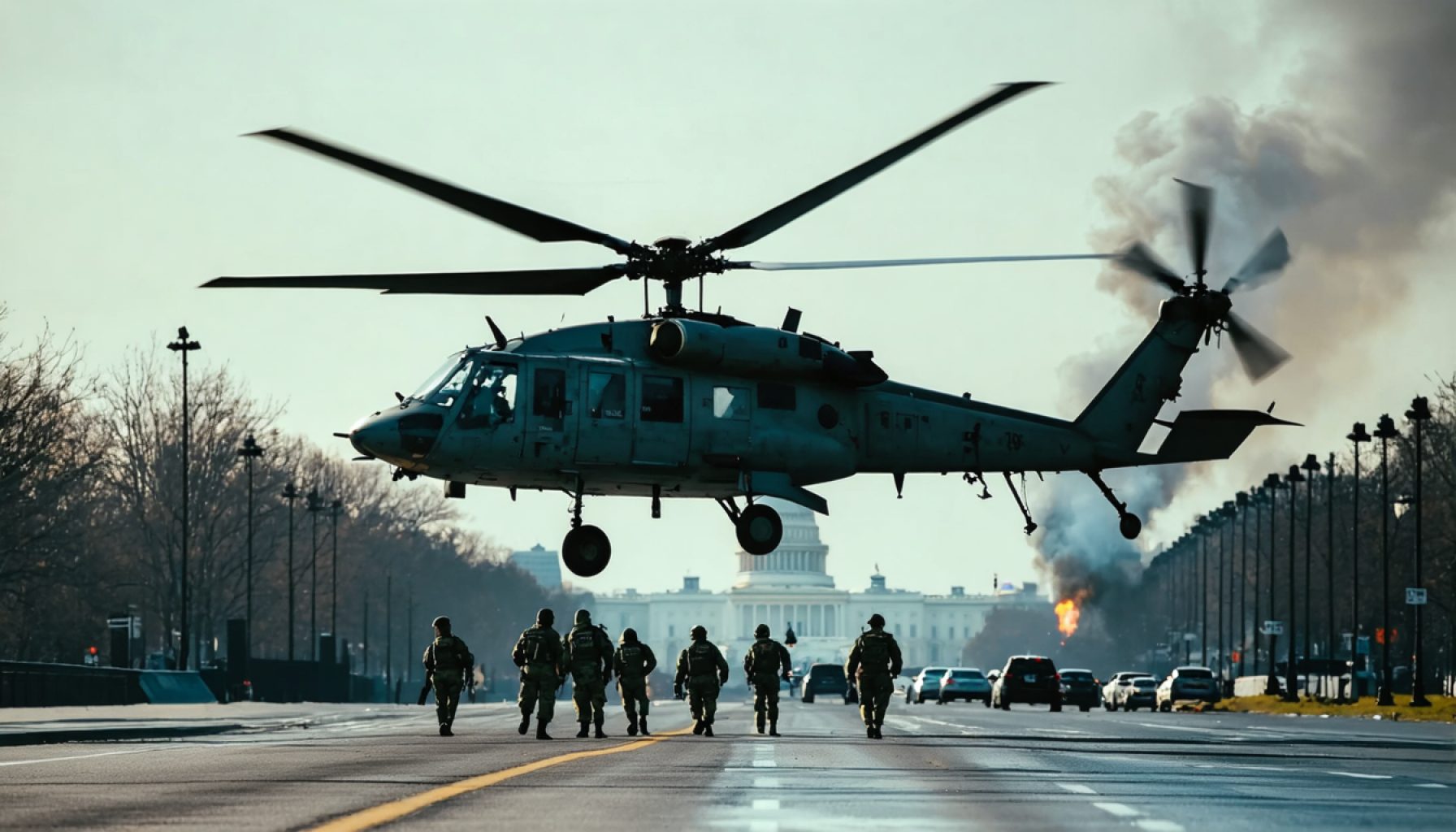- The U.S. Army revamps air operations around Washington, D.C., following a fatal collision between a Black Hawk helicopter and a commercial jet, resulting in 67 casualties.
- New measures prioritize the use of the Automatic Dependent Surveillance-Broadcast system (ADS-B) to enhance airspace transparency and safety.
- Under Brig. Gen. Matthew Braman’s guidance, the Army limits flights without ADS-B-out data to prevent further accidents.
- VIP helicopter flights have been significantly reduced, with operations now limited to essential personnel like high-ranking defense officials.
- The Army installs 1,600 ADS-B-in systems to improve communication between aircraft and air traffic controllers, ensuring greater visibility.
- Airspace coordination and communication remain crucial, with the FAA removing risk-prone flight paths to enhance safety over the Potomac.
- The response highlights a commitment to transparency and safety, emphasizing the role of technology and collaboration in aviation operations.
In the sprawling skies above the nation’s capital, a subtle yet profound transformation takes place in response to a fateful night this past January. The U.S. Army, burdened by a tragic collision between one of its Black Hawk helicopters and a commercial jet, has undertaken a decisive shift in how its aircraft navigate the critical airspace surrounding Washington, D.C.
Picture this: darkened skies, a ballet of aircraft threading the night, until two paths regrettably cross, leaving 67 souls lost and questions spiraling through the wind. At the heart of the turmoil lies controversy surrounding the use—or lack thereof—of the Automatic Dependent Surveillance-Broadcast system, commonly known by its acronym, ADS-B. It’s a piece of technology that, while ubiquitous in commercial aviation, was rarely used by the military on sensitive missions.
Hovering at the center of these changes is Brig. Gen. Matthew Braman, the Army’s stalwart aviation commander. Under his guidance, the Army initiates a series of steps aimed at minimizing such perilous occurrences. Key among these moves is a reduction in flights with the ADS-B-out data switched off—an effort to bolster transparency in an airspace teeming with civilian and military traffic alike.
As night becomes day, it’s not just helicopters cloaked in silence that undergo scrutiny. VIP flights speculating across Washington are now sharply curtailed. Once a familiar sight were military chariots ferrying high-ranking officers between the Pentagon and the nation’s outer loci. Today, only the most crucial flights—those carrying figures like the defense and deputy defense secretaries—trace the trails in the sky, their operations more circumspect, their presence not shrouded.
The challenges posed by this change are not insurmountable. The installation of 1,600 ADS-B-in systems—allowing aircraft to receive position data from others—becomes a testament to the Army’s commitment to enhancing aviation safety. Alas, such undertakings do not come without cost, yet safety outvalues all expenditure.
ADSB-in and ADSB-out combine to keep aircraft visible when signals falter, aiding both pilots in cockpits and controllers on the ground. Although still pending thorough investigation, assumptions that the Army crew flew without ADS-B-out remain speculative. What is known, however, is the Black Hawk’s transponder radiated its identity through different modes, ensuring airspace visibility even amidst controversy.
Reflecting on the tragedy, the Army’s adjustments resonate with an urgent refrain: coordination and communication stand paramount. As the FAA eliminates flight paths inviting risk over the Potomac, it hopefully signals a proactive approach to airspace safety.
In this tale of tragedy leading to transformation, the Army beckons a message to all who traverse the skies—a commitment to embrace transparency and collaboration. Enhanced technology and tailored flight paths illuminate a pledge to safeguard not just military operations but every soul who dreams of flying across the vast expanse above us.
How a Tragedy in the Skies is Revolutionizing Military Aviation Safety
In response to a devastating accident above Washington, D.C. involving a Black Hawk helicopter and a commercial jet, the U.S. Army is undergoing significant changes in airspace management and aircraft operation protocols. This transformation underscores a critical shift towards transparency and safety, with implications for both military and civilian aviation.
Overview of the Changes
The collision, which resulted in the loss of 67 lives, highlighted the need for more stringent safety measures in military aviation, particularly regarding the use of Automatic Dependent Surveillance-Broadcast (ADS-B) technology. Traditionally sparing in its application during sensitive missions, the military is now reconsidering its stance on ADS-B usage.
Key Reforms:
– Increased ADS-B Implementation: The Army plans to install 1,600 ADS-B-in systems to enhance situational awareness for pilots and ground controllers.
– Limiting Non-essential Flights: VIP flights around Washington, once routine, have been significantly reduced. Only essential flights carrying top defense officials are allowed.
– Improved Safety Protocols: Flight paths over risky areas such as the Potomac have been reassessed to minimize danger.
Why is ADS-B Important?
ADS-B technology is crucial for both airspace safety and collision prevention. It allows aircraft to broadcast their location and speed to air traffic control and other equipped aircraft. There are two components:
– ADS-B Out: Transmits an aircraft’s GPS position, velocity, and other data.
– ADS-B In: Allows an aircraft to receive such information from other planes, enhancing situational awareness.
Real-World Use Cases
– Enhanced Collision Avoidance: By ensuring all aircraft are visible, even amidst signal disruptions, both pilots in the sky and controllers on the ground benefit from improved situational awareness.
– Efficient Airspace Management: Facilitates smoother civil-military airspace coordination, reducing potential mid-air collisions.
– Crisis Response & Management: During emergencies, improved data sharing aids quicker, coordinated response efforts.
Industry Trends and Comparisons
A gradual shift towards full ADS-B compliance is observed globally, with mandates like those in the U.S. airspace, boosting safety. Commercial aviation has long adopted ADS-B, which is now increasingly embedded in military fleets.
Controversies and Limitations
Despite its advantages, ADS-B’s susceptibility to data spoofing and cyber threats presents challenges. The military often uses encrypted or alternative surveillance methods in sensitive situations to mitigate these risks.
Actionable Recommendations
1. Pilots and Aerospace Professionals: Enhance your understanding of ADS-B technology through training and certification programs.
2. Military Planners: Develop secure, adaptive protocols integrating ADS-B while addressing specific mission needs.
3. Aviation Enthusiasts: Follow industry updates for technological advancements and policy changes regarding ADS-B usage.
Conclusion
The Army’s proactive steps in response to this tragedy aim to set a precedent for airspace safety. Enhanced transparency, collaboration, and technology upgrades signal a future where military and civilian aviation sectors can operate with heightened safety and efficiency.
For more insights into aviation safety and technology, you can check resources from the FAA and National Transportation Safety Board (NTSB) at FAA and NTSB.








